HND人力资源管理导论人力作业2
- 格式:doc
- 大小:53.50 KB
- 文档页数:5
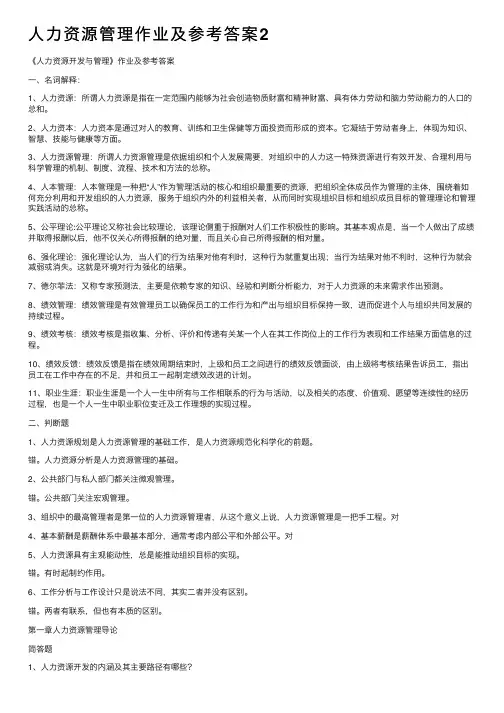
⼈⼒资源管理作业及参考答案2《⼈⼒资源开发与管理》作业及参考答案⼀、名词解释:1、⼈⼒资源:所谓⼈⼒资源是指在⼀定范围内能够为社会创造物质财富和精神财富、具有体⼒劳动和脑⼒劳动能⼒的⼈⼝的总和。
2、⼈⼒资本:⼈⼒资本是通过对⼈的教育、训练和卫⽣保健等⽅⾯投资⽽形成的资本。
它凝结于劳动者⾝上,体现为知识、智慧、技能与健康等⽅⾯。
3、⼈⼒资源管理:所谓⼈⼒资源管理是依据组织和个⼈发展需要,对组织中的⼈⼒这⼀特殊资源进⾏有效开发、合理利⽤与科学管理的机制、制度、流程、技术和⽅法的总称。
4、⼈本管理:⼈本管理是⼀种把“⼈”作为管理活动的核⼼和组织最重要的资源,把组织全体成员作为管理的主体,围绕着如何充分利⽤和开发组织的⼈⼒资源,服务于组织内外的利益相关者,从⽽同时实现组织⽬标和组织成员⽬标的管理理论和管理实践活动的总称。
5、公平理论:公平理论⼜称社会⽐较理论,该理论侧重于报酬对⼈们⼯作积极性的影响。
其基本观点是,当⼀个⼈做出了成绩并取得报酬以后,他不仅关⼼所得报酬的绝对量,⽽且关⼼⾃⼰所得报酬的相对量。
6、强化理论:强化理论认为,当⼈们的⾏为结果对他有利时,这种⾏为就重复出现;当⾏为结果对他不利时,这种⾏为就会减弱或消失。
这就是环境对⾏为强化的结果。
7、德尔菲法:⼜称专家预测法,主要是依赖专家的知识、经验和判断分析能⼒,对于⼈⼒资源的未来需求作出预测。
8、绩效管理:绩效管理是有效管理员⼯以确保员⼯的⼯作⾏为和产出与组织⽬标保持⼀致,进⽽促进个⼈与组织共同发展的持续过程。
9、绩效考核:绩效考核是指收集、分析、评价和传递有关某⼀个⼈在其⼯作岗位上的⼯作⾏为表现和⼯作结果⽅⾯信息的过程。
10、绩效反馈:绩效反馈是指在绩效周期结束时,上级和员⼯之间进⾏的绩效反馈⾯谈,由上级将考核结果告诉员⼯,指出员⼯在⼯作中存在的不⾜,并和员⼯⼀起制定绩效改进的计划。
11、职业⽣涯:职业⽣涯是⼀个⼈⼀⽣中所有与⼯作相联系的⾏为与活动,以及相关的态度、价值观、愿望等连续性的经历过程,也是⼀个⼈⼀⽣中职业职位变迁及⼯作理想的实现过程。
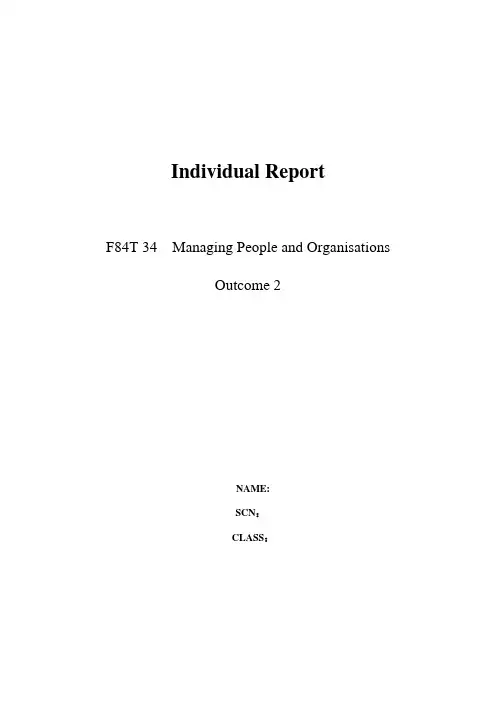
Individual ReportF84T 34 Managing People and OrganisationsOutcome 2NAME:SCN:CLASS:ContentsIntroduction (3)Section1: Content and Process Theory within Application (3)Section 2: Methods improving job performance (4)Section 3a: Importance of Teamwork (5)Section 3b: Three factors affecting team cohesiveness and performance .. 5 Conclusion (6)Reference (6)IntroductionThree points in this report. Using the Maslow’s theory analysis the Shangri-la hotel in the case。
The benefits of expectancy theory。
Combining with case write five ways to improve performance. The content of the final includes Belbin—team roles and contribution and three factors influencing of team cohesion. The following is the main content of the paper.Section1:Content and Process Theory within ApplicationMas low’s theory:Maslow's theory is put forward by Maslow in the mid-1950s. Maslow describes the human needs into the same pyramid from low to high level be divided into five kinds。
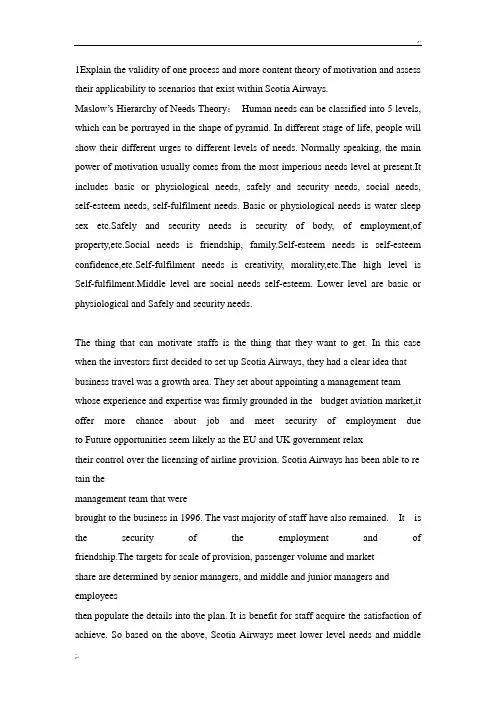
1Explain the validity of one process and more content theory of motivation and assess their applicability to scenarios that exist within Scotia Airways.Maslow’s Hierarchy of Needs Theory:Human needs can be classified into 5 levels, which can be portrayed in the shape of pyramid. In different stage of life, people will show their different urges to different levels of needs. Normally speaking, the main power of motivation usually comes from the most imperious needs level at present.It includes basic or physiological needs, safely and security needs, social needs, self-esteem needs, self-fulfilment needs. Basic or physiological needs is water sleep sex etc.Safely and security needs is security of body, of employment,of property,etc.Social needs is friendship, family.Self-esteem needs is self-esteem confidence,etc.Self-fulfilment needs is creativity, morality,etc.The high level is Self-fulfilment.Middle level are social needs self-esteem. Lower level are basic or physiological and Safely and security needs.The thing that can motivate staffs is the thing that they want to get. In this case when the investors first decided to set up Scotia Airways, they had a clear idea that business travel was a growth area. They set about appointing a management team whose experience and expertise was firmly grounded in the budget aviation market,it offer more chance about job and meet security of employment due to Future opportunities seem likely as the EU and UK government relaxtheir control over the licensing of airline provision. Scotia Airways has been able to re tain themanagement team that werebrought to the business in 1996. The vast majority of staff have also remained. It is the security of the employment and of friendship.The targets for scale of provision, passenger volume and marketshare are determined by senior managers, and middle and junior managers and employeesthen populate the details into the plan. It is benefit for staff acquire the satisfaction of achieve. So based on the above, Scotia Airways meet lower level needs and middlelevel needs, but don’t meet higher level needs.Vroom’s Expectancy Theory : It states that an individual tends to act in a certain way, in the expectation that the act will be followed by a given outcome, and according to the attractiveness of that outcome. Vroom maintain that high levels of effort lead to high performance and high performance will lead to the attainment of reward.If the reward is desire outcomes, staff will have effort again. High motivation consist of high expectancy ,high instrumentality and high valence. But Scotia Airway don’t use this theory.The investors in Scotia Airways have set an ambitious programme for expansion over the next 5 years to include long haul destinations. Somemembers of the management team and many workers are concerned that thechange in strategy will change the ethos and culture of the business.Because of this expansion plan as outcome is not positive for the individual, not a personal desire and does not reflect the above relationsh ip, so staffs’ views are not uniform.2Given the range and complexity of challenges faced by the management of Scotia Airways, summarise methods that could be implement to improve job performance and justify how each provides added value to the organization.In this case, The investors in Scotia Airways have set an ambitious programme for expansion over the next 5 years to include long haul destinations. Somemembers of the management team and many workers are concerned that thechange in strategy will change the ethos and culture of the business.They meet the resistance of expansion and revolution.Other problem is coordination between branches.So the following manner can solve these problem.Team-working:The interdependency relationship that exits in a org that will facilitate improved performance, especially in service industry.Team-working in favor of the outbreak of the potential to help the company's development.Empowerment:Authorizing staff to make decisions on such as resource allocation, operating problem solving and during customer interaction will improve the efficiency and quality of working.Advisable authorization in favor of self-management subsidiaries and reduce force of higher manager.Training:Every employee should have appropriate training before or during working. This is much more important when an org is newly developed or in the process of expansion.When the expansion of revolution, training staff to unify their thinking.Target-setting:A series of determined SMART targets to motivate andcontrol employees.Setting objective.The objective should be SMART-specific,measurable,attainable,realisitic,time-specific. It is good for unity.Endeavoring the same objective is conducive development of company.3Explain why the introduction of teamworking is fundamental to the achievement of the goals of Scotia Airways and identify the main costs and benefits they may encounter as result.The main value of team is their ability to assemble and empower employees to coordinate together, and use their talents to improve the organization. In teamworking, organisation will be clearly structured, and more fully participating in decisions and planning how work will be performed. It also benefits the employee's motivation and job satisfaction.Teamworking always can improve coordination/communication, staff development, conflict management quality and productivity.This is a virtuous cycle. For example, Members cooperate with each other in the team,and it improves coordination/communication ,because better coordination/communication can get better efficiency, it can improve quality andefficiency. Good coordination also is good for improving staff development. When staffs achieve goals, they will happy together. It helps to reduce conflict management.The last result is that company’s productivity get improvement largely.But, team also takes some problem.Teamwork may have an unintended effect of fermenting hostility toward the managerial goal of making the teams fully self-managing. The conflicts between individual and team objectives.For example,Some members of the management team and many workers are concerned that the change in strategy will change the ethos and culture of the business.Teamworking is not an one-day work, it will cost a long period of training.When company expand, it must adopt more team. But a good team must been trained ,it has to lots of spending.Supervision should be applied in every stage of team process.In this case, a lot of things are decided by only Rosa.Because some team process don’t apply, it isn’t good to authorize.At another aspect,it increase management’s cost.4Identify three factors that could impact upon team cohesion and performance within Scotia Airways and assess their potential impact.These can improve cohesion selection of appropriate supervisor, team size, trust and effective delegationSelection of appropriate supervisor: A successful always have wise leader. The wise leader can release the potential power of team at the most. In this case, Rosa Dallevic is in overall charge, assisted by her long-term colleague, Azim Ishtiaq. She has alsoemployed the same personal assistant, Katrin Wright, since she joined Scotiaand this has helped promote consistency and continuity. They are sensible leader. Rose also a strong and decisive manager. Though they don’t create some value directly, staffs have enough enthusiasm and motivation due to appropriate supervisor.Team size: The size is the smaller the better normally. In this case Scotia Airways has been an increase in staffing levels, anincrease in budgets and an increase in capital investment. It currently employs executi ves and managers in marketing, finance, HR and flight operations with operational and administrative staff within each department. To expand the size appropriately is benefit to allow company adapt the trend in the future when company expands. Team always consist of simple people.In team they can release their ability better. I f team size is excessive ,it will take force in finance and also isn’t good to management.In this article, Scotia Airways don’t have the performance of team. They can make improvements in this aspect.Trust: Trust is good for improve team cohesion and performance. If a team discredit each other ,it will disband quickly. In this case, A culture of trust has been emphasised and developed by both the management and workers and this has served to enhance the effectiveness, efficiency and overall performance of the business. It will boost Scotia Airways ‘s staffs’ enthusiasm when trust has been a culture in company.Effective delegation:It helps higher managers better administrate company.If higher managers deal with all things, he will be tired and have more error-prone. Therefore, it is important to delegate effectively. In this case, The targets for scale of provision, passenger volume and market shareare determined by senior managers, and middle and junior managers and employeesthen populate the details into the plan. It promotes efficiency.As far as I’m considered these strategies can improve cohesiveness and performance, learning from mistakes and listening to others.Learning from mistakes can shortcoming and avoid the same mistakes in the future. Listening to others can get information that we don’t have, sometime ,we get inspiration from the words of others.。
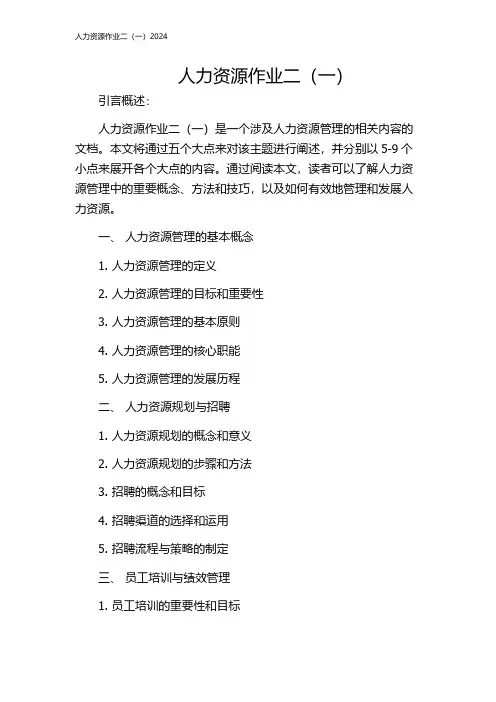
人力资源作业二(一)引言概述:人力资源作业二(一)是一个涉及人力资源管理的相关内容的文档。
本文将通过五个大点来对该主题进行阐述,并分别以5-9个小点来展开各个大点的内容。
通过阅读本文,读者可以了解人力资源管理中的重要概念、方法和技巧,以及如何有效地管理和发展人力资源。
一、人力资源管理的基本概念1. 人力资源管理的定义2. 人力资源管理的目标和重要性3. 人力资源管理的基本原则4. 人力资源管理的核心职能5. 人力资源管理的发展历程二、人力资源规划与招聘1. 人力资源规划的概念和意义2. 人力资源规划的步骤和方法3. 招聘的概念和目标4. 招聘渠道的选择和运用5. 招聘流程与策略的制定三、员工培训与绩效管理1. 员工培训的重要性和目标2. 员工培训的需求分析和设计3. 培训方法和工具的选择4. 绩效管理的概念和流程5. 绩效评估和奖励激励机制的建立四、薪酬管理与员工福利1. 薪酬管理的概念和意义2. 薪酬制度的设计和发展趋势3. 薪酬调查与薪酬测算方法4. 员工福利的概念和种类5. 员工福利的管理和福利政策的制定五、人力资源信息系统与员工关系1. 人力资源信息系统的概念和作用2. 人力资源信息系统的构建和运用3. 员工关系的重要性和管理原则4. 员工关系的维护与处理5. 员工投诉与冲突解决的方法与技巧总结:通过本文的阐述,我们可以看到人力资源管理在组织中的重要性和作用。
从人力资源管理的基础概念、人力资源规划与招聘、员工培训与绩效管理、薪酬管理与员工福利,以及人力资源信息系统与员工关系五个大点的阐述中,我们可以了解到人力资源管理的核心内容和方法。
通过有效的人力资源管理,组织可以更好地利用和开发人员的潜力,提高员工满意度和组织绩效。
因此,人力资源管理是组织成功的重要因素之一。
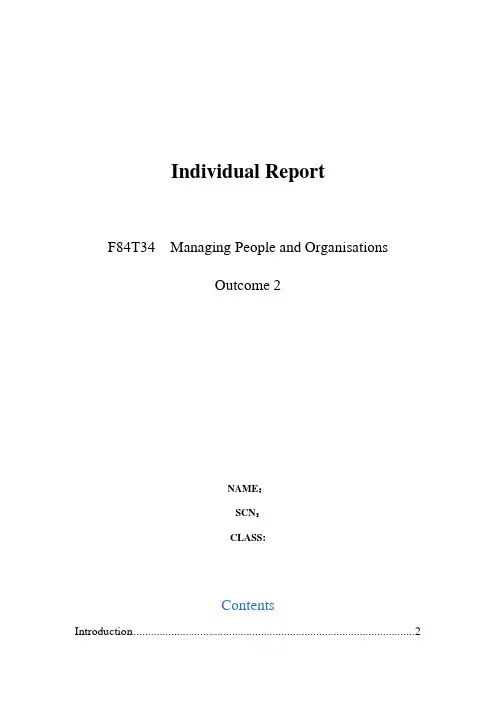
Individual ReportF84T34 Managing People and OrganisationsOutcome 2NAME:SCN:CLASS:ContentsIntroduction (2)Section1: Content and Process Theory within Application (2)Section 2: Methods improving job performance (3)Section 3a:Importance of Teamwork (4)Section 3b: Three factors affecting team cohesiveness and performance .. 5 Conclusion (5)Reference (5)IntroductionThree points in this report。
Using the Maslow’s theory analysis the Shangri-la hotel in the case. The benefits of expectancy theory。
Combining with case write five ways to improve performance。
The content of the final includes Belbin-team roles and contribution and three factors influencing of team cohesion. The following is the main content of the paper.Section1:Content and Process Theory within ApplicationMaslow's theory:Maslow’s theory is put forward by Maslow in the mid-1950s。
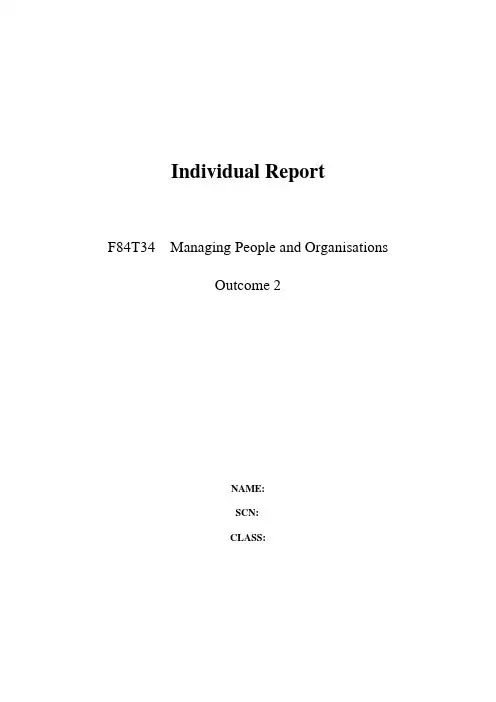
Individual ReportF84T34 Managing People and OrganisationsOutcome 2NAME:SCN:CLASS:ContentsIntroduction (3)Section1: Content and Process Theory within Application (3)Section 2: Methods improving job performance (4)Section 3a: Importance of Teamwork (5)Section 3b: Three factors affecting team cohesiveness and performance .. 5 Conclusion (6)Reference (6)IntroductionThree points in this report. Using the Maslow’s theory analysis the Shangri-la hotel in the case. The benefits of expectancy theory. Combining with case write five ways to improve performance. The content of the final includes Belbin-team roles and contribution and three factors influencing of team cohesion. The following is the main content of the paper.Section1: Content and Process Theory within ApplicationMaslow’s theory:Maslow’s theory is put forward by Maslow in the mid-1950s. Maslow describes the human needs into the same pyramid from low to high level be divided into five kinds. The Shangri-La Hotel’s kitchen staff are analyzes and bases on an analysis of Maslow’s the ory.Basic and physiological needs: The kitchen staff have physiological needs. So the Shangri-La Hotel mast offers kitchen staff food and shelter. The Shangri-La Hotel promises kitchen staff the satisfaction of physiological needs. Kitchen staff will definitely work hard.Safety and security needs:The kitchen staff have safety and security needs. The Shangri-La Hotel must provide insurance for kitchen staff personal safety. Shangri-La links with insurance companies and insurance companies provide kitchen staff insurance.Social needs:Kitchen staff maintains kitchen’s regular operation. Kitchen staff are important part in kitchen. Kitchen staff hard work in the kitchen, has is able to realize self-value.Ego needs: Craig is a sous chef but he does not respect the views of his employees. Craig is not to given the ego of kitchen staff. Kitchen staff want respect, so Craig mast given ego of kitchen staff and kitchen staff mast self-respect.Self-fulfilment needs:Kitchen staff has their purpose and intents. Kitchen staff realizes their value in the work and make their progress in the work. Kitchen staff works hard and become a chef.ConclusionMaslow’s hierarchy has diversification. People at different times have different needs.Maslow proposed that all humans seek to fulfill a hierarchy of needs. His hierarchy be represented with a pyramid by him. The potential has kitchen staff’s need and people have potential demand. Maslow’s hierarchy has variability. People have different demand in different environments.Expectancy theoryExpectancy theory is put forward by Vroom. Expectancy theory that motivation is heightened when behaviors are highly instrumental in achieving desires outcomes. Instrumentality includes the Shangri-La hotel Managers wants have reward system and rewards can include a promotion and a rise. The reward system mast befit the employees’ expectations. Manager’s valences for rewards weather or not employees be attracted by reward and reward positive or negative impact on employee.ConclusionThe discretion of the expected value is embodied by self-interest. Manager’s Rewards System attracts employs but rewards system depends on human’s subjectivity and experience.Section 2: Methods improving job performanceThere are so many ways to improve job performance such as job design, quality of working life, the nature of supervision, use of technology, the meaningfulness of work, job rotation and improving job performance of team members, autonomy and reward. Select five points combines with casesJob design: Chef’s personal methods influence hotel management.Craig preventswaiting staff deal with the problem that affect efficiency. Redistribution of power from Craig’s power to managers. So Shangri-La Hotel improves the processing efficiency that conducive hotel developmentReward:Shangri-La Hotel sets up a bonus system. Rewards can improve staff motivation. Alisa rewards hotel staff who studies in local collage. Hotel staff studies in collage can improve their service quality that for the hotel development. Alisa can finding the most successful people and promoting them out and take them become manages.Job rotation:Shangri-La hotel need training programs, such as rotations. Alisa can get managers working on every area of the site in hotel, so they know differentworking environment and they have a variety of work experience. Job rotation can help managers eliminates the monotony of work.Use of technology:Use of technology in the Shangri-La hotel’s kitchen. Upgrade the production line and reduced operating costs. Use of technology in the kitchen can improves the production efficiency.Autonomy: Sous chef has a new menu but Craig do not agree to use the new menu to cook. Sous chef has his power so sous can talk about the benefits of the new menu with C raig and introduces a new menu in order to better meet customer’s demands.Section 3a: Importance of TeamworkA team must have a common purpose or goal. The team cooperation can increase batter to satisfying objectives. Team increase enterprise competitiveness. The team cooperation van improving productivity and enhances service quality and innovative. The team cooperation can increases motivation and commitment.Belbin-team roles and contribution:Belbin thinks not prefer individual, only has the perfect team. Belbin-team’s content includes Monitor Evaluator, Team worker, Completer Finisher, Specialist, Implementer, Co-ordinator, Shaper, Plant, Resource Investigator.Tuckman-stage of team: Tuckman put the team growth into four stage. Four stage includes forming, storming, norming, performing and performing stages.Section 3b: Three factors affecting team cohesiveness and performanceTeam cohesiveness is very important to a team. Team cohesiveness is essential can plays an important role in digging out its potential and keeping the team exist. A cohesive team is an eligible team.Three factors, which effect the team cohesion and performance in the kitchen of hotel case.Size of team:Case of no team in the kitchen.Craig is in the kitchen range to set up a s mall team. Small team effort would be a much more efficient approach. The Craig’s team include the delegates of work in the kitchen. Craig’s team discuss the problemsabout kitchen related that can make up for many of the problems before, such as lack of consultation, poor communication and lack of participation.Lack ofcommunication: Craig is a personal totalitarian people due to he is lack of communication with his staff in the kitchen. Leading to the lack of cohesive force in the kitchen. Strengthen the communication between managers and employees that can improve team cohesion.Team members are positive and motivated: In the kitchen, the manager mast has the intense affinity and builds a consummation system. Managers build a good atmosphere, encourages various staffs positively upward. Positive the kitchen staff, unity and stability that conducive to team development.ConclusionTeam cohesion not only can increase the efficiency but also can enhance friendship among colleagues. Managers uses Maslow’s theory and Expectancy theory to managing employees. Team cohesion makes group with high cohesiveness, closely condensed group numbers, strive for group’s goal together. The last hope hotel has a long development.ReferenceLaurie J. Mullins, Management and Organisational Behavior, Seventh Edition, Financial Times Prentice Hall (2005)Steven L. McShane, Mary Ann Von Glinow, Organizational Behavior, Fourth Edition, McGraw-Hill lrwin。
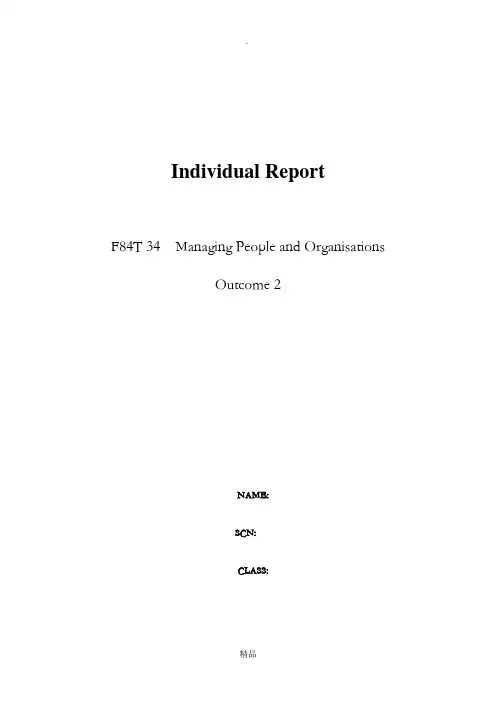
Individual ReportF84T 34 Managing People and OrganisationsOutcome 2NAME:SCN:CLASS:ContentsIntroduction (3)Section1: Content and Process Theory within Application (3)Section 2: Methods improving job performance (4)Section 3a: Importance of Teamwork (5)Section 3b: Three factors affecting team cohesiveness and performance (5)Conclusion (6)Reference (6)IntroductionThree points in this report. Using the Maslow’s theory analysis the Shangri-la hotel in the case. The benefits of expectancy theory. Combining with case write five ways to improve performance. The content of the final includes Belbin-team roles and contribution and three factors influencing of team cohesion. The following is the main content of the paper.Section1: Content and Process Theory within Application Maslow’s theory:Maslow’s theory is put forward by Maslow in the mid-1950s. Maslow describes the human needs into the same pyramid from low to high level be divided into five kinds. The Shangri-La Hotel’s kitchen staff are analyzes and bases on an analysis of Mas low’s theory.Basic and physiological needs:The kitchen staff have physiological needs. So the Shangri-La Hotel mast offers kitchen staff food and shelter. The Shangri-La Hotel promises kitchen staff the satisfaction of physiological needs. Kitchen staff will definitely work hard.Safety and security needs:The kitchen staff have safety and security needs. The Shangri-La Hotel must provide insurance for kitchen staff personal safety. Shangri-La links with insurance companies and insurance companies provide kitchen staff insurance. Social needs:Kitchen staff maintains kitchen’s regular operation. Kitchen staff are important part in kitchen. Kitchen staff hard work in the kitchen, has is able to realize self-value.Ego needs: Craig is a sous chef but he does not respect the views of his employees. Craig is not to given the ego of kitchen staff. Kitchen staff want respect, so Craig mast given ego of kitchen staff and kitchen staff mast self-respect.Self-fulfilment needs: Kitchen staff has their purpose and intents. Kitchen staff realizes their value in the work and make their progress in the work. Kitchen staff works hard and become a chef.ConclusionMaslow’s hierarchy has diversification. People at different times have different needs. Maslow proposed that all humans seek to fulfill a hierarchy of needs. His hierarchy be represented with a pyramid by him. The potential has kitchen staff’s need and people have potential demand. Maslow’s hierarchy has variability. People have different demand in different environments.Expectancy theoryExpectancy theory is put forward by Vroom. Expectancy theory that motivation is heightened when behaviors are highly instrumental in achieving desires outcomes. Instrumentality includes the Shangri-La hotel Managers wants have reward system and rewards can include a promotion and a rise. The reward system mast befit the employees’ expectations. Manager’s valences for rewards weather or not employees be attracted by reward and reward positive or negative impact on employee.ConclusionThe discretion of the expected value is embodied by self-interest. Manager’s Rewards System attracts employs but rewards system depends on human’s subjectivity and experience.Section 2: Methods improving job performanceThere are so many ways to improve job performance such as job design, quality of working life, the nature of supervision, use of technology, the meaningfulness of work, job rotation and improving job performance of team members, autonomy and reward. Select five points combines with casesJob design: Chef’s personal methods influence hotel management.Craig prevents waiting staff deal with the problem that affect efficiency. Redistribution of power from Craig’s power to managers. So Shangri-La Hotel improves the processing efficiency that conducive hotel developmentReward: Shangri-La Hotel sets up a bonus system. Rewards can improve staff motivation. Alisa rewards hotel staff who studies in local collage. Hotel staff studies in collage can improve their service quality that for the hotel development. Alisa can finding the most successful people and promoting them out and take them become manages.Job rotation: Shangri-La hotel need training programs, such as rotations. Alisa can get managers working on every area of the site in hotel, so they know different working environment and they have a variety of work experience. Job rotation can help managers eliminates the monotony of work.Use of technology: Use of technology in the Shangri-La hotel’s kitchen. Upgrade the production line and reduced operating costs. Use of technology in the kitchen can improves the production efficiency.Autonomy: Sous chef has a new menu but Craig do not agree to use the new menu to cook. Sous chef has his power so sous can talk about the benefits of the new menu with Craig and introduces a new menu in order to better meet customer’s demands.Section 3a: Importance of TeamworkA team must have a common purpose or goal. The team cooperation can increase batter to satisfying objectives. Team increase enterprise competitiveness. The team cooperation van improving productivity and enhances service quality and innovative. The team cooperation can increases motivation and commitment.Belbin-team roles and contribution:Belbin thinks not prefer individual, only has the perfect team. Belbin-team’s content includes Monitor Evaluator, Team worker, Completer Finisher, Specialist, Implementer, Co-ordinator, Shaper, Plant, Resource Investigator.Tuckman-stage of team: Tuckman put the team growth into four stage. Four stage includes forming, storming, norming, performing and performing stages.Section 3b: Three factors affecting team cohesiveness and performanceTeam cohesiveness is very important to a team. Team cohesiveness is essential can plays an important role in digging out its potential and keeping the team exist. A cohesive team is an eligible team.Three factors, which effect the team cohesion and performance in the kitchen of hotel case.Size of team:Case of no team in the kitchen.Craig is in the kitchen range to set up a small team. Small team effort would be a much more efficient approach. The Craig’s team include the delegates of work in the kitchen. Craig’s team discuss the problems about kitchen related that can make up for many of the problems before, such as lack of consultation, poor communication and lack of participation.Lack of communication: Craig is a personal totalitarian people due to he is lack of communication with his staff in the kitchen. Leading to the lack of cohesive force in the kitchen. Strengthen the communication between managers and employees that can improve team cohesion.Team members are positive and motivated:In the kitchen, the manager mast has the intense affinity and builds a consummation system. Managers build a good atmosphere, encourages various staffs positively upward. Positive the kitchen staff, unity and stability that conducive to team development.ConclusionTeam cohesion not only can increase the efficiency but also can enhance friendship among colleagues. Managers uses Maslow’s theory and Expectancy theory to managing employees. Team cohesion makes group with high cohesiveness, closely condensed group numbers, strive for group’s goal together. The last hope hotel has a long development.ReferenceLaurie J. Mullins, Management and Organisational Behavior, Seventh Edition, FinancialTimes Prentice Hall (2005)Steven L. McShane, Mary Ann Von Glinow, Organizational Behavior, Fourth Edition, McGraw-Hill lrwin如有侵权请联系告知删除,感谢你们的配合!如有侵权请联系告知删除,感谢你们的配合!。
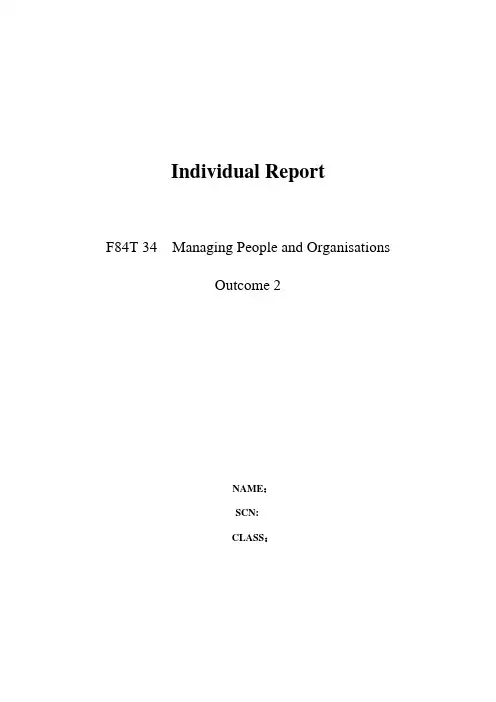
Individual ReportF84T 34 Managing People and OrganisationsOutcome 2NAME:SCN:CLASS:ContentsIntroduction (3)Section1: Content and Process Theory within Application (3)Section 2: Methods improving job performance (4)Section 3a: Importance of Teamwork (5)Section 3b: Three factors affecting team cohesiveness and performance .. 5 Conclusion (6)Reference (6)IntroductionThree points in this report. Using the Maslow’s theory analysis the Shangri-la hotel in the case. The benefits of expectancy theory. Combining with case write five ways to improve performance. The content of the final includes Belbin-team roles and contribution and three factors influencing of team cohesion。
The following is the main content of the paper。
Section1: Content and Process Theory within ApplicationMas low’s theory:Maslow’s theory is put forward by Maslow in the mid-1950s。
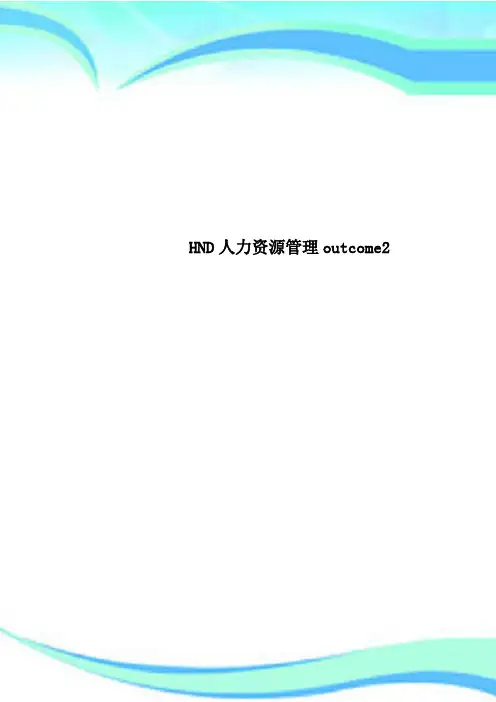
HND人力资源管理outcome2————————————————————————————————作者:————————————————————————————————日期:Individual ReportF84T 34 Managing People and OrganisationsOutcome 2NAME:SCN:CLASS:Contents Introduction (5)Section1: Content and Process Theory within Application (5)Section 2: Methods improving job performance (6)Section 3a: Importance of Teamwork (7)Section 3b: Three factors affecting team cohesiveness and performance.. 7 Conclusion (8)Reference (8)IntroductionThree points in this report. Using the Maslow’s theory analysis the Shangri-la hotel in the case. The benefits of expectancy theory. Combining with case write five ways to improve performance. The content of the final includes Belbin-team roles and contribution and three factors influencing of team cohesion. The following is the main content of the paper.Section1: Content and Process Theory within ApplicationMaslow’s theory:Maslow’s theory is put forward by Maslow in the mid-1950s. Maslow describes the human needs into the same pyramid from low to high level be divided into five kinds. The Shangri-La Hotel’s kitchen staff are analyzes and bases on an analysis of Maslow’s theory.Basic and physiological needs: The kitchen staff have physiological needs. So the Shangri-La Hotel mast offers kitchen staff food and shelter. The Shangri-La Hotel promises kitchen staff the satisfaction of physiological needs. Kitchen staff will definitely work hard.Safety and security needs:The kitchen staff have safety and security needs. The Shangri-La Hotel must provide insurance for kitchen staff personal safety. Shangri-La links with insurance companies and insurance companies provide kitchen staff insurance.Social needs:Kitchen staff maintains kitchen’s regular operation. Kit chen staff are important part in kitchen. Kitchen staff hard work in the kitchen, has is able to realize self-value.Ego needs: Craig is a sous chef but he does not respect the views of his employees. Craig is not to given the ego of kitchen staff. Kitchen staff want respect, so Craig mast given ego of kitchen staff and kitchen staff mast self-respect.Self-fulfilment needs:Kitchen staff has their purpose and intents. Kitchen staff realizes their value in the work and make their progress in the work. Kitchen staff works hard and become a chef.ConclusionMaslow’s hierarchy has diversification. People at different times have different needs. Maslow proposed that all humans seek to fulfill a hierarchy of needs. His hierarchy be represented with a pyramid by him. The potential has kitchen staff’s need and people have potential demand. Maslow’s hierarchy has variability. People have different demand in different environments.Expectancy theoryExpectancy theory is put forward by Vroom. Expectancy theory that motivation is heightened when behaviors are highly instrumental in achieving desires outcomes. Instrumentality includes the Shangri-La hotel Managers wants have reward system and rewards can include a promotion and a rise. The reward system mast befit the employees’ expectations. Manager’s valences for rewards weather or not employees be attracted by reward and reward positive or negative impact on employee.ConclusionThe discretion of the expected value is embodied by self-interest. Manager’s Rewards Sy stem attracts employs but rewards system depends on human’s subjectivity and experience.Section 2: Methods improving job performanceThere are so many ways to improve job performance such as job design, quality of working life, the nature of supervision, use of technology, the meaningfulness of work, job rotation and improving job performance of team members, autonomy and reward. Select five points combines with casesJob design: Chef’s personal methods influence hotel management.Craig prevents waiting staff deal with the problem that affect efficiency. Redistribution of power from Craig’s power to managers. So Shangri-La Hotel improves the processing efficiency that conducive hotel developmentReward:Shangri-La Hotel sets up a bonus system. Rewards can improve staff motivation. Alisa rewards hotel staff who studies in local collage. Hotel staff studies in collage can improve their service quality that for the hotel development. Alisa can finding the most successful people and promoting them out and take them become manages.Job rotation: Shangri-La hotel need training programs, such as rotations. Alisa can get managers working on every area of the site in hotel, so they know different working environment and they have a variety of work experience. Job rotation can help managers eliminates the monotony of work.Use of technology: Use of technology in the Shangri-La hotel’s kitchen. Upgrade the production line and reduced operating costs. Use of technology in the kitchen can improves the production efficiency.Autonomy: Sous chef has a new menu but Craig do not agree to use the new menu to cook. Sous chef has his power so sous can talk about the benefits of the new menu with Craig and introduces a new menu in order to better meet customer’s demands.Section 3a: Importance of TeamworkA team must have a common purpose or goal. The team cooperation can increase batter to satisfying objectives. Team increase enterprise competitiveness. The team cooperation van improving productivity and enhances service quality and innovative. The team cooperation can increases motivation and commitment.Belbin-team roles and contribution:Belbin thinks not prefer individual, only has the perfect team. Belbin-team’s content in cludes Monitor Evaluator, Team worker, Completer Finisher, Specialist, Implementer, Co-ordinator, Shaper, Plant, Resource Investigator.Tuckman-stage of team: Tuckman put the team growth into four stage. Four stage includes forming, storming, norming, performing and performing stages.Section 3b: Three factors affecting team cohesiveness and performanceTeam cohesiveness is very important to a team. Team cohesiveness is essential can plays an important role in digging out its potential and keeping the team exist. A cohesive team is an eligible team.Three factors, which effect the team cohesion and performance in the kitchen of hotel case.Size of team:Case of no team in the kitchen.Craig is in the kitchen range to set up asmall team. Small team effort w ould be a much more efficient approach. The Craig’s team include the delegates of work in the kitchen. Craig’s team discuss the problems about kitchen related that can make up for many of the problems before, such as lack of consultation, poor communication and lack of participation.Lack of communication: Craig is a personal totalitarian people due to he is lack of communication with his staff in the kitchen. Leading to the lack of cohesive force in the kitchen. Strengthen the communication between managers and employees that can improve team cohesion.Team members are positive and motivated: In the kitchen, the manager mast has the intense affinity and builds a consummation system. Managers build a good atmosphere, encourages various staffs positively upward. Positive the kitchen staff, unity and stability that conducive to team development.ConclusionTeam cohesion not only can increase the efficiency but also can enhance friendship among colleagues. Managers uses Maslow’s theory and Expectancy theory to managing employees. Team cohesion makes group with high cohesiveness, closely condensed g roup numbers, strive for group’s goal together. The last hope hotel has a long development.ReferenceLaurie J. Mullins, Management and Organisational Behavior, Seventh Edition, Financial Times Prentice Hall (2005)Steven L. McShane, Mary Ann Von Glinow, Organizational Behavior, Fourth Edition, McGraw-Hill lrwin。
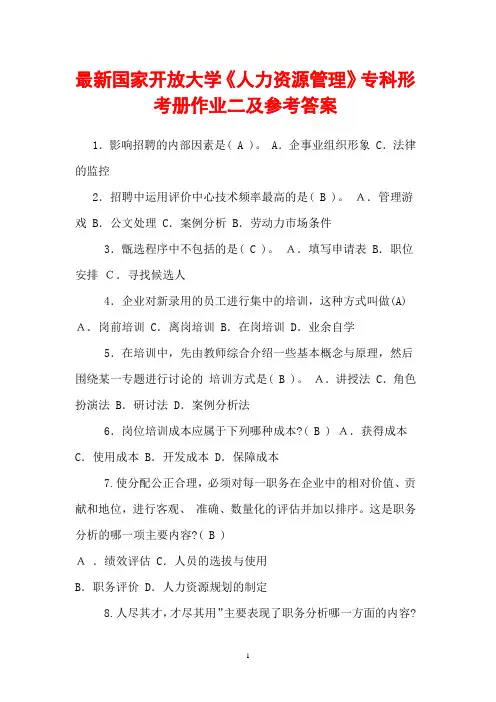
最新国家开放大学《人力资源管理》专科形考册作业二及参考答案1.影响招聘的内部因素是( A )。
A.企事业组织形象 C.法律的监控2.招聘中运用评价中心技术频率最高的是( B )。
A.管理游戏 B.公文处理 C.案例分析 B.劳动力市场条件3.甑选程序中不包括的是( C )。
A.填写申请表 B.职位安排C.寻找候选人4.企业对新录用的员工进行集中的培训,这种方式叫做(A) A.岗前培训 C.离岗培训 B.在岗培训 D.业余自学 5.在培训中,先由教师综合介绍一些基本概念与原理,然后围绕某一专题进行讨论的培训方式是( B )。
A.讲授法 C.角色扮演法 B.研讨法 D.案例分析法6.岗位培训成本应属于下列哪种成本?( B ) A.获得成本C.使用成本 B.开发成本 D.保障成本7.使分配公正合理,必须对每一职务在企业中的相对价值、贡献和地位,进行客观、准确、数量化的评估并加以排序。
这是职务分析的哪一项主要内容?( B )A.绩效评估 C.人员的选拔与使用B.职务评价 D.人力资源规划的制定8.人尽其才,才尽其用”主要表现了职务分析哪一方面的内容?(C) A.组织结构的设计C.人员的选拔与使用B.人力资源规划的制定 D.培训计划的制定9.在招募、选择、录用和安置员工的过程中所发生的费用称为(A)A.人力资源的获得成本 C.人力资源的使用成本 B.人力资源的开发成本 D.人力资源保障成本10.人员分析,确定人员标准。
这是招聘选拔工作的哪一阶段? (A)A.准备阶段 C.选择阶段 B.实施阶段 D.检验效度阶段11.招工简章,进行“安民告示” 。
这是企业每年一次招聘录用工作的哪个阶段?(B) A.筹划与准备阶段 C.考核与录用阶段B.宣传与报名阶段 D.岗前教育与安置阶段12.程序的变化性比较有限,工作性质是半重复性的,需要一些决策运作。
这是一种什么样的培训策略?( B ) A.日常工作C.工作操作程序有变化 B.按细节说明的工作 D.计划和操作复杂的工作13.考评指标设计分为( C )个阶段。
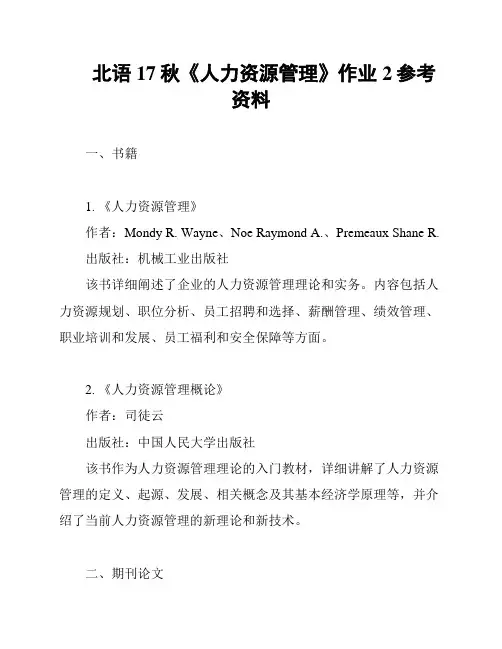
北语17秋《人力资源管理》作业2参考
资料
一、书籍
1. 《人力资源管理》
作者:Mondy R. Wayne、Noe Raymond A.、Premeaux Shane R.
出版社:机械工业出版社
该书详细阐述了企业的人力资源管理理论和实务。
内容包括人力资源规划、职位分析、员工招聘和选择、薪酬管理、绩效管理、职业培训和发展、员工福利和安全保障等方面。
2. 《人力资源管理概论》
作者:司徒云
出版社:中国人民大学出版社
该书作为人力资源管理理论的入门教材,详细讲解了人力资源管理的定义、起源、发展、相关概念及其基本经济学原理等,并介绍了当前人力资源管理的新理论和新技术。
二、期刊论文
1. “控制论与人力资源管理——职业性心理健康的维系”
作者:苏光洋、张吉普
期刊:《渭南师范专科学校学报》
2017年,第36卷,第3期,共30页。
该论文针对职业性心理健康问题,提出了基于控制论的人力资源管理策略,并对其可行性进行了实证研究。
2. “企业人力资源管理的现状和发展趋势”
作者:李冬
期刊:《工业技术经济》
2017年,第36卷,第8期,共5页。
该论文针对中国企业人力资源管理现状和发展趋势进行了调查和分析,对企业人力资源管理的新趋势和新模式进行了展望。
三、网络资源
1. 中华人民共和国人力资源和社会保障部官网
该网站是中华人民共和国人力资源和社会保障部的官方网站,包含了相关政策、法规、展会、单位信息等方面的内容。
2. 中国人力资源网
该网站是中国较早的人力资源门户网站之一,提供最新的HR 新闻、招聘信息、培训资讯、HR政策法规等,还提供招聘和求职信息服务。
《人力资源管理导论》作业参考答案一、选择题(请在列出的备选答案中选出正确答案)1.认为人力资源是具有劳动能力的全部人口的观点属于( A )。
A.成年人口观 B.在岗人员观C.人员素质观2.人力资源与人力资本在 D 这一点上有相似之处。
A.品性 B.态度 C.经验 D.形式3.具有内耗性特征的资源是( B )。
A.自然资源 B.人力资源 C.矿产资源4.“人力资源管理,即负责组织人员的招聘、甄选、训练及报酬等功能的活动,以达成个人与组织的目标。
”这一概念属于( A )。
A.过程揭示论 B.目的揭示论C.现象揭示论 D.综合揭示论5.人力资源管理与人事管理的主要区别体现在( B )。
A.内容上 B.观念上C.工作程序上6.以“任务管理”为主要内容的泰勒的“科学管理原理,是在哪种人性假设基础上提出来的? ( A )A.经济人 B.社会人 C.自我实现人 D.复杂人7.“社会人”人性理论假设的基础是什么?( D )A.泰勒的科学管理原理B.梅奥的人际关系理论C.马斯洛的需要层次理论D.霍桑试验8.以人性为核心的人本管理的主体是何种基本要素?( A )A.职工 B.环境 C.文化 D.价值观9.期望激励理论属于哪种类型的激励理论?( B )A.内容型激励理论 B.过程型激励理论C.行为改造型激励理论 D.综合激励理论10.通常制约人们士气、创造力、生产效率和目标实现程度的组织气候属于哪种环境类型? ( B )A.组织外部环境 B.组织内部环境C.物质环境 D.人文环境11.某企业对10名新招来的员工进行上岗前培训,从讲课到实习一共花了5000元费用,1请问这笔费用应从人力资源成本的哪个项目中列支?( B )A.获得成本 B.开发成本 C.使用成本 D.保障成本12.预测由未来工作岗位的性质与要求所决定的人员素质和技能的类型,这是制定人力资源规划时哪一个步骤?( B )A.预测未来的人力资源供给B.预测未来的人力资源需求C.供给与需求的平衡D.制定能满足人力资源需求的政策和措施13.从现实的应用形态来看;下面哪个方面不是人力资源所应包含的内容?( C ) A.体质 B.智力 C.思想 D.技能14.“只有真正解放了被管理者,才能最终解放管理者自己。
《人力资源管理导论》作业参考答案一、选择题(请在列出的备选答案中选出正确答案)1.认为人力资源是具有劳动能力的全部人口的观点属于( A )。
A.成年人口观 B.在岗人员观C.人员素质观2.人力资源与人力资本在 D 这一点上有相似之处。
A.品性 B.态度 C.经验 D.形式3.具有内耗性特征的资源是( B )。
A.自然资源 B.人力资源 C.矿产资源4.“人力资源管理,即负责组织人员的招聘、甄选、训练及报酬等功能的活动,以达成个人与组织的目标。
”这一概念属于( A )。
A.过程揭示论 B.目的揭示论C.现象揭示论 D.综合揭示论5.人力资源管理与人事管理的主要区别体现在( B )。
A.内容上 B.观念上C.工作程序上6.以“任务管理”为主要内容的泰勒的“科学管理原理,是在哪种人性假设基础上提出来的? ( A )A.经济人 B.社会人 C.自我实现人 D.复杂人7.“社会人”人性理论假设的基础是什么?( D )A.泰勒的科学管理原理B.梅奥的人际关系理论C.马斯洛的需要层次理论D.霍桑试验8.以人性为核心的人本管理的主体是何种基本要素?( A )A.职工 B.环境 C.文化 D.价值观9.期望激励理论属于哪种类型的激励理论?( B )A.内容型激励理论 B.过程型激励理论C.行为改造型激励理论 D.综合激励理论10.通常制约人们士气、创造力、生产效率和目标实现程度的组织气候属于哪种环境类型? ( B )A.组织外部环境 B.组织内部环境C.物质环境 D.人文环境11.某企业对10名新招来的员工进行上岗前培训,从讲课到实习一共花了5000元费用,1精品文档就在这里-------------各类专业好文档,值得你下载,教育,管理,论文,制度,方案手册,应有尽有-------------- --------------------------------------------------------------------------------------------------------------------------------------------请问这笔费用应从人力资源成本的哪个项目中列支?( B )A.获得成本 B.开发成本 C.使用成本 D.保障成本12.预测由未来工作岗位的性质与要求所决定的人员素质和技能的类型,这是制定人力资源规划时哪一个步骤?( B )A.预测未来的人力资源供给B.预测未来的人力资源需求C.供给与需求的平衡D.制定能满足人力资源需求的政策和措施13.从现实的应用形态来看;下面哪个方面不是人力资源所应包含的内容?( C ) A.体质 B.智力 C.思想 D.技能14.“只有真正解放了被管理者,才能最终解放管理者自己。
1Explain the validity of one process and more content theory of motivation and assess their applicability to scenarios that exist within Scotia Airways.Maslow’s Hierarchy of Needs Theory:Human needs can be classified into 5 levels,which can be portrayed in the shape of pyramid。
In different stage of life,people will show their different urges to different levels of needs. Normally speaking,the main power of motivation usually comes from the most imperious needs level at present.It includes basic or physiological needs,safely and security needs, social needs, self—esteem needs,self—fulfilment needs。
Basic or physiological needs is water sleep sex etc。
Safely and security needs is security of body,of employment,of property,etc。
Social needs is friendship,family。
Self—esteem needs is self-esteem confidence,etc.Self—fulfilment needs is creativity,morality,etc。
The human resource management for Escape to the Wild Introduction: This report is an advantage report for Escape to the Wild, in it, we will talk about its human resource management and how to manage it more better. We will also give some advantages to its line manager. It will also talk about the joyful influence for this company.1.The human resource management can be defined as a strategic and coherent approach to the management of an organization’s most valued assets: the people working there who individually and collectively contribute to the achievement of its objectives.The range of human resource management activities are human resource planning, recruitment and selection, job analysis and design, training and development, employee relations, pay and reward, employee welfare, performance management and appraisal, ensuring fair employment practice.In this report, I will talk about four activities: human resource planning, recruitment and selection, job analysis and design and training and development.(1) Human resource planningThe human resource planning’s function and purpose:●To ensure that firm has right number of people, in the right place, with the rightskills at the right time.●To support firms’ expansion strategy.●To ensuring HR resource supplements humane resource demands.●To set human resource objectives and deciding how to meet them.Do human resource planning need to employees need for a company, it include inside and outside predict. The process of human resource planning includes three steps:●How many employees will we need?The expected demand for company’s product of service is most important when forecasting personnel needs.●How many candidates will be supplied inside of organization?A qualifications inventory can facilitate forecasting the supply of internal candidates.●Forecasting the supply of outside candidates.If there are not enough qualified inside candidates to fill anticipated openings, employers focus next on projecting supplies of outside candidates. This may require forecasting general economic conditions, local labor market conditions, and occupations market conditions.This activity is very useful for this company, because it can enable that the employee movements into, within, and out of organization are smooth/less disruptive and sound HRM decision making. Through these parts, they can effect on many parts in the company, at last, it can become the competitive advantage.Escape to the Wild is lake of human resource planning through its development, if they do it well, then the company will has its own competitive advantage.(2) Job analysisJob analysis is the procedure through which you determine the duties of these jobs and the characteristics of the people who should be hired for them. It includes twoparts: job description and person specifications. Its purpose is to produce information on the job’s activities and requirements. It has three processes like next:●Collecting job analysis information.To carry out job analysis need comprehensive information about certain job.●Writing job description.A job description is a written statement of what the jobholder does, how he or she does it, and under what conditions the job is preferment.●Writing person specifications.Person specification shows details of the personal qualities an individual will need to perform a particular job. A person specification sets out the skills, characteristics and attributes that a person needs to do a particular job.It can enable that competent, motivated employees with positive job attitudes, job-related HRM and minimized HRM-related lawsuits.In this case, through its development the company is begun to do it, because of this, the company is developing fast and become bigger than before. The job analysis let some competitive advantages to this company.(3) Recruitment and selectionRecruitment is the process of identifying the need for a new employee, defining the job attracting candidates and selecting those best suited for the job.Selection is the process of choosing which person to appoint from those that apply for a job vacancy.Recruitment and selection are usually considered as one process. However, we will make the distinction here between the initial actions and considerations when planning staff recruitment and the process of selecting an individual from a pool of applicants.The purpose of recruitment and selection is that. Recruitment involves attracting the right standard of applicants to apply for vacancies. Selection involves choosing the most suitable people from those that apply for a vacancy; this ensures that those selected for interview have the best fit wit the job requirements.The process of recruitment and selection is like next:●Vacancy review●Applying to fill a vacancy●Preparation of job description and person specification●Preparing a recruitment advertisement●Placing the advertisement●Receipt of applications●Arrange selection interviews and other selection activities●Write to successful and unsuccessful candidates at various stages of the process ●Evaluation of the recruitment and selection processIt could ensure recruit high-quality applicants, if a company has high-quality employees, then productive employees can increase overall productivity and improved chances of selecting best qualified and training needs and costs are minimized, through these best parts and combine with this company’s situation, if it can have high-quality employees and take low cost for the employees training. Thoseare helping the company developing well.(4) Training and developmentTraining and development refers to a “planned effort by an organization to facilitate the learning of job-related behavior on the part of its employees”. Training and development is also a means to provide employees with relevant skills so as to improve the efficiency of their organization.The goals and function of training and developing are like next:●To improve an individual’s level of self- awareness●To improve an individual’s skill in one or more areas of expertise●To increase an individual’s motivation to perform his or her job●To grow its own managers and promote from within●To help retain good quality employeesThe processes of T&D are like next:●Identifying training needs●Producing T&D planning●Implementing T&D planning●Evaluating the programThrough good T&D, the company could improve employee competence, permanent change in KSAs of new employees and permanent change in KSAs of current employees.In a word, Escape to the Wild can through these parts in its own company to improve his produce and his quickly development in the world.2.(1)Through the case company, we can see that the management structure isn’t wonderful for this company. In this company, it has 300 staffs, but its structure of the human resource management function isn’t having full function in this firm, so we need to improve it to help the company developing better. I will take some advantages to it. From next picture, the company didn’t have the last department in its structure that is HR director, this department is this case company are building now.Because of 300 staffs in this form, in some operations, the ratio of HR department staff to the number of employees is one for every 100 employees or one for every 200 employees, so it suitable to 1:100 management situation, so we only need to add two or three HR director’s member, so the new structure picture is like next, it has five departments and the HR director is the new one.The positions of HR department are always including these:●Director of human resources●Labor relations specialist(director of labor relations)●Employment manager●Payroll administrator●Benefits administrator●Director of training/ training managerThrough the fact of this company and the theory, so we can see the next structure is much more suitable for the company.Managing DirectorMarketing Advisor Personal AssistantFinance Director Online and Mail Order Retail Outlets Purchase and HR Director Sales Director Director Distribution Director1accountant 2IT/web specialists 10store 1warehouse manager 1training2finance 1mail-order managers 1buying manager manager supervisors manager 20assistant 3distribution 1HR recruiter 8finance 1assistant mail- store managers supervisorsassistants order manager 150full-time/ 5buyers2secretarial 3sales team leaders part-time/casual 15dispatch/support staff 30full-time/part-time retail staff warehouse staffcustomer service staff 4secretarial/ 4secretarial/4secretarial/admin admin staff admin staffstaffThe HR director guides and management the overall provision of human resource services, policies, and programs for the entire company. He originates and leads HR practices and objectives that will provide an employee-oriented, high performance culture. The HR director coordinates implementation of services, policies, and programs through HR staff, he is also need to do reports to the CEO and serves on the executive management team, and assists and advises company management about HR issues.The corporate human resource recruiter is responsible for delivering all facets of recruiting success through the organization. We can employ a HR recruiter to deal with recruits’problem. The corporate human resources recruiter will play a critical role in ensuring we are hiring the best possible talent.●Develop and execute recruiting plans.●Network through industry contracts, association.●Coordinate and implement college recruiting initiatives.●Administrative duties and keep records.So through the company’s fact we need HR Director and HR Recruiter to manage the company’s human resource management.(2) The human resource management’s operation is based on the line managers, because of the line managers are the last users in the company, so they need to cooperate with human resource managers to do human resource management well to assure the company develop well.Line managers’ HRM responsibilities are like next:●Placing the right person in the right job●Starting new employees in the organizations●Training employees for jobs that are new to them●Improving the job performance of each person●Gaining creative cooperation and developing smooth working relationships●Interpreting the company’s policies and procedures●Controlling labor costs●Developing the abilities of each person●Creating and maintaining departmental morale●Protecting employees’ health and physical conditions3.If the company provides good human resource management, then it will take good psychological contract.The psychological contract is that the perceptions of the two parties, employee and employer, of what their mutual obligations are towards each other.The contextual and background factors will effect on the policy and practice and then will be the psychological, all will effect on the state of the psychotically contract, at last we will have the outcome. The manager could through good psychological contract to provide good situations for his employees and make good relationships with them, this will have good effect on the company, and also have many advantage with employees and employers.In this report we talk about a lot of functions and effects on human resource management for a company, and we also based on the case company to provide them. Through these parts, we also help the case company improve its management on human resource management.。